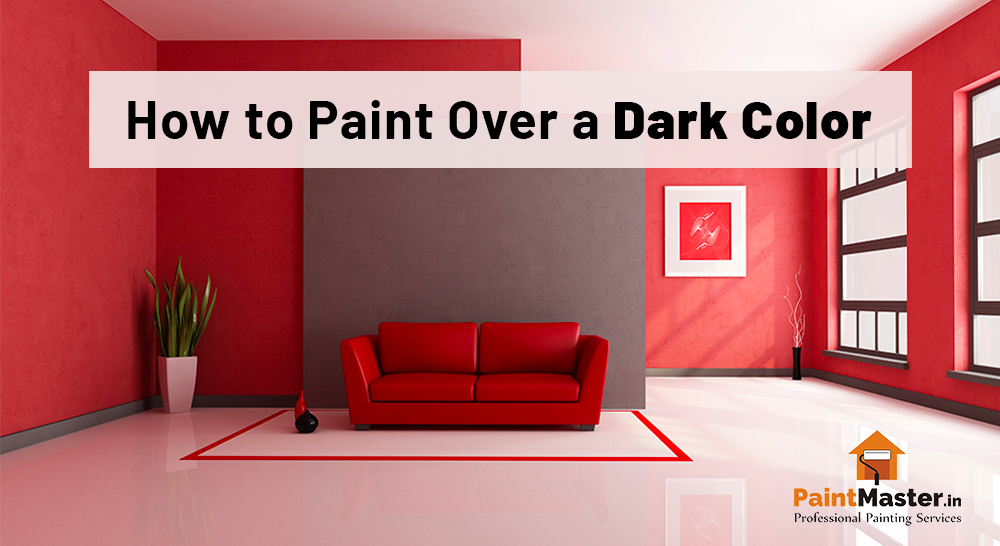How to Paint Over a Dark Color

Painting a room can be an excellent way to update and refresh the look of your home. However, if you’re painting over a dark color, it can be a daunting task. Dark colors can be difficult to cover up, and if you don’t take the right steps, your new paint job may end up looking patchy or uneven. Fortunately, with the right techniques and tools, you can successfully paint over a dark color and achieve a smooth, even finish. In this blog post, we’ll provide you with some helpful painting tips to ensure that your next painting project is a success. Whether you’re a DIY enthusiast or a beginner, these tips will help you achieve a professional-looking paint job that will leave your room looking fresh and bright.
Painting and moving frequently go hand in hand. It’s only fair to want to infuse your own style into your new house, and painting the walls is probably the simplest method to create a noticeable impact. Even though it’s still an easy process to complete on one’s own, things become a little more challenging if you wish to paint over a dark color with a lighter one.
Dark colors provide a beautiful initial appearance when painted on. If and when you decide to paint a room a dark hue, it’s probably because you are in love with the shade, it complements a certain piece of wood, or a design or design magazine has suggested it.
However, it won’t endure forever, just like any paint color. The patterns could also alter over time in addition to fading. You can simply grow weary of seeing the same tint every day. Painting over dark colors is challenging, so even though you want to repaint, you decide against it. Painting over any dark hue is difficult, but red walls provide one of the biggest obstacles. Always take a second to consider your choice before going for red. Consider hiring a professional painter by contacting Paintmasters.
When it comes to painting over a dark color, there are specific steps you need to follow to ensure a smooth, even finish. Painting over dark walls can be a challenging task, but with the right tools and techniques, it can be done quickly and easily. In this blog post, we will discuss the steps involved in painting over dark walls to help you achieve a professional-looking paint job. By following these steps, you can transform any room with dark walls into a bright and welcoming space that you’ll love spending time in. So, let’s get started!
Steps involved to paint dark walls
- Preparation
You must understand that preparation is the first step when trying to paint over darker colors. Your walls should be as spotless as possible. After giving them a good cleaning, scrape off any flaking paint or other uneven areas of the wall. Once you begin the task of covering your dark-colored walls, you want to ensure that they appear as spotless as possible.
- Pick a primer
Primer is definitely something you’ve heard of before, but perhaps you’ve never needed it. So the moment has come. Preparation with primer is usually necessary when painting on dark walls. An undercoat called a primer boosts durability and provides a surface that encourages better adhesion. Apply a good primer as instructed on the container. The better the primer, the fewer coats you’ll need. If you’re unsure of the best primer for your darker walls, ask a professional at the hardware or paint store for advice. The ability to paint over dark colors should always be a specialty of residential painting professionals.
- Using Primer
For the darker walls, you could need three coats of primer, at the very least. Cutting corners here is not a good idea. It won’t matter whether you select the finest color to cover dark surfaces if you don’t use enough priming. Primers perform better with several thin coatings than with one heavy coat because coats encourage evenness. There are several alternatives available for priming your walls. Even if you pick the thinnest color you might find, it will still dry true to color without any traces of the previous, deeper hue. The finest color to cover dark hues in one coat should be applied after carefully priming your dark walls.
- Paint
To cover dark walls, choose the best paint; in other words, always choose quality. The finest paint to conceal dark colors in one coat is going to need to be of high caliber; inexpensive paint won’t do. Similar to how picking a high-quality primer will increase your chances of successfully covering the old, dark paint, a high-quality paint will do the same. Although there are certain paints that only need one coat, use two to make sure your darker walls are well covered. Even if you have the best color to cover dark walls, don’t give up if you require two coats. Applying a top coat and getting the desired effects is considerably preferable to applying only one and being dissatisfied with how your property turns out.
Do you intend to renovate your home? Is there a possibility of painting the entire house this year? You can have the task done swiftly and professionally with the aid of a professional painting contractor like Paintmasters.
In conclusion, painting over a dark color can be a challenging task, but with these painting tips, you can make the process much easier and achieve a beautiful, even finish. Remember to always start with proper preparation, use high-quality materials, and take your time to ensure that each coat of paint is fully dry before applying the next one. With these techniques in mind, you can transform any dark room into a bright and welcoming space that you’ll love spending time in. So, why not give it a try? Get your paintbrushes ready and start your next painting project today! And don’t forget to share your experience with us in the comments below. Happy painting!
FAQ
It’s generally recommended to prime the walls first, especially if the color you are painting over is significantly darker than the new color. This will help ensure that the new paint adheres properly and looks even.
It’s best to use a high-quality paint that is specifically formulated to cover dark colors. Look for paint with high hiding properties or labeled as “paint and primer in one” to ensure good coverage.
It depends on the darkness of the original color and the opacity of the new paint. In most cases, two coats of paint should be sufficient. However, if you’re using a particularly light color or if the original color is very dark, you may need to apply three coats.
Related Posts
Table Of Content
Offers Coming Soon..
Blog Category
Categories
Latest Blogs
Looking for the best painter in mumbai.
Call us today
Error: Contact form not found.
GET A FREE QUOTATION
- 300 people booked painting services in last 7 days







